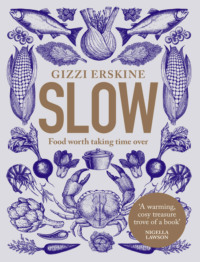
Полная версия
Restore
1 large onion, peeled and quartered
2–3 fresh green jalapeños, stalks removed and cut in half (seeds or no seeds, depending on your preference)
1 head of garlic, cloves peeled
3 tbsp oil
juice of 3 big juicy limes
1 tsp salt
very large bunch of coriander, leaves picked
Put the green tomatoes, onion, jalapeños and garlic in a food processor and blitz until smooth.
Heat the oil in a frying pan over a medium heat, pour in the tomato mixture and cook for 10 minutes, allowing it to reduce, then squeeze in the lime juice. Add the salt, then the coriander. Allow to cook for a further minute, return to the food processor and blitz again to achieve a really smooth sauce. Serve at room temperature.
The salsa will keep for up to 2–3 days in the fridge.
Green Shakshuka
I developed this recipe in the early days of Filth, with Rosemary Ferguson. Our mission was to get extra nutrition into everyday dishes. We wanted to make a healthy breakfast, both loved shakshuka and huevos rancheros, and thought we could somehow merge them. That week, I’d made a huge vat of Green Tomato Salsa that ended up being the base of this dish. We fried some cumin seeds in oil then added the salsa, before blending it with fresh spinach to an even more nutritious, virtually Hulk-green sauce, got some roasted green peppers into the dish and baked the eggs in this sauce instead of the usual red one. We finished it with a combo of Middle Eastern and Mexican toppings and served it with flatbreads or grilled Turkish breads with some good extra-virgin olive oil. It’s a superb healthy weekend brunch dish and pretty fancy-pants in the impressiveness stakes, too.
SERVES 2
Preparation time 10 minutes
Cooking time 10 minutes
3 tbsp olive oil
1 tsp cumin seeds
400g Green Tomato Salsa
1 tsp ground coriander
85g fresh spinach, washed, wilted in a pan for a minute and drained
80g green peppers, roasted (see here) and sliced
4 free-range eggs
sea salt and freshly ground black pepper
TO SERVE
good handful of coriander leaves, chopped
a few dill fronds
a few mint leaves, shredded
2 tbsp sour cream
300g Queso Fresco, made to a firm and crumbly texture
3 tbsp toasted mixed seeds mixed with ½ tsp za’atar
freshly made Flatbreads or grilled Turkish bread
extra-virgin olive oil, for drizzling
You will need 2 individual 22–25cm baking or gratin dishes.
Preheat the oven to 240°C/220°C fan/gas mark 9.
Heat the oil in a frying pan over a medium-high heat, add the cumin seeds and fry for a minute or two until toasted. Add the green tomato salsa, coriander and spinach and cook for a minute. Season with salt and pepper if necessary, then remove from the heat and blitz until smooth.
Divide the blitzed sauce between two individual (22–25cm) ovenproof baking or gratin dishes. Split the green peppers between the two dishes, then simply make two little holes in the top of the sauce in each dish and break an egg into each hole. Season each egg with salt and pepper and bake in the oven for about 8 minutes or until the egg whites are cooked through, but the eggs still have runny yolks.
Remove from the oven and top the two shakshukas with the chopped coriander, dill, mint, sour cream, queso fresco and seeds, and serve with toasted or warmed bread, drizzled with extra-virgin olive oil.
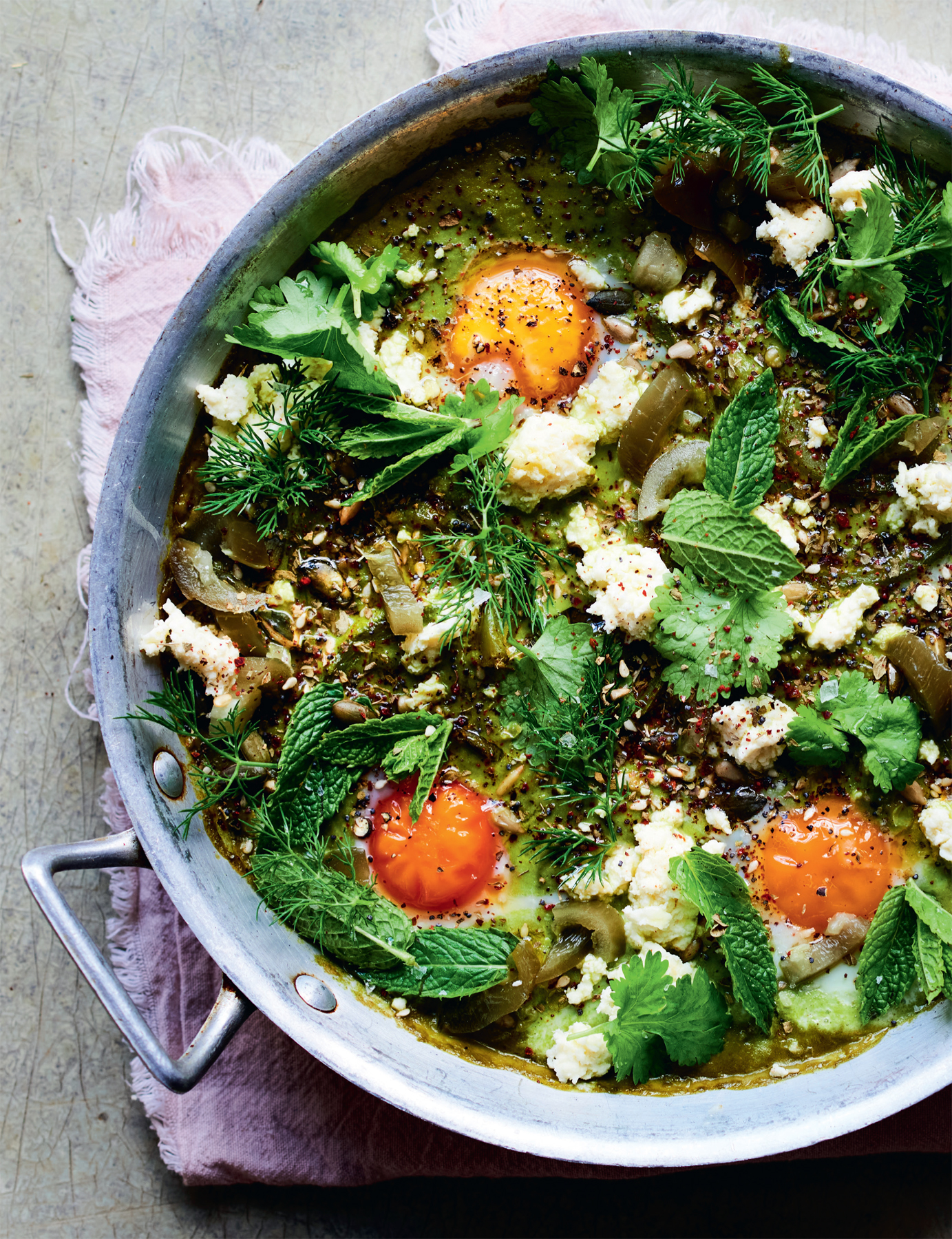
Pumpkin Seed and Cocoa Mole Sauce for pumpkins, poultry and beans
Mole is a traditional Mexican sauce that generally contains a fruit, a chilli pepper, a nut, a seed, and spices like cinnamon, black pepper and cumin. The word ‘mole’ is an archaic word for ‘mix’, and some of the very traditional ones, like mole poblano, contain about 24 different ingredients. This recipe is a little simpler than that, but it’s still deep and richly flavoured.
You can cook poultry pieces in the mole, but I prefer poaching a whole bird in a spiced broth made with onions, bay leaves, thyme, cinnamon, star anise and peppercorns, leaving the bird to cool, and using the poaching liquor in the mole sauce, in place of the chicken stock, then lacquering the cooked chicken meat with it. Another classic way to use mole is to roast large chunks of deseeded pumpkin or squash (see cooking method here) and serve them with the sauce.
To make a really phenomenal plant-based meal, serve this mole with Rye Tortillas, Queso Fresco and Green Tomato Salsa, swapping the chicken stock in the mole for vegetable stock.
MAKES 500g (200g is enough for tacos for 4–6 people and it freezes really well)
Preparation time 20 minutes
Cooking time 1 hour
3–4 tbsp oil
3 largish onions, thinly sliced
1 head of garlic, cloves peeled
600g tomatoes
2 dried Mexican chillies, such as ancho, mulato, ñora, guindilla, pasilla, chipotle, etc.
2 tbsp ground cumin
½ tsp ground cinnamon
¼ tsp ground cloves
generous grating of nutmeg
50g unsalted cashews
25g pumpkin seeds
6 prunes
500ml fresh chicken stock or poaching liquor
2 tsp cocoa powder
juice of 1 orange
juice of 1 lime
sea salt and freshly ground black pepper
Heat about 2 tablespoons of the oil in a heavy-based casserole dish over a medium-low heat, add the onions and garlic and cook for a good 20 minutes until really soft and sweet, golden and just beginning to caramelise. Turn off the heat while you prepare the rest of the ingredients.
Next, you need to char the tomatoes. Traditionally, this is done over a naked flame, but if you whack your oven up as hot as it can go (to about 260°C/240°C fan/gas mark 10) and roast them in a roasting tray for 10–12 minutes, you can achieve a really good char and the tomatoes intensify in flavour. It’s up to you, but ultimately you need to achieve burnt skins. Once you have done this, put them in a food processor (with their skins) and blitz until smooth.
Heat the remaining oil in a deep frying pan over a medium-high heat. Add the dried Mexican chillies, all of the spices, cashews and pumpkin seeds and fry for a few minutes until everything is toasty and brown, being careful not to scorch the chillies. Transfer the nuts, seeds, spices and dried chillies to the casserole dish with the onions and garlic, then pour in the blitzed tomatoes, add the prunes and chicken stock or poaching liquor and allow to reduce for 10 minutes.
Carefully transfer everything to a food processor and blitz for at least 2 minutes until you have a smooth sauce. Clean out the casserole dish and return the smooth mole to it. Now let it reduce over a medium heat for about 20 minutes, until it has the consistency of double cream. Finally, stir in the cocoa powder, check for seasoning and add the lime juice and orange juice.
Globe Artichokes with Real Salad Cream
The moment that sticks in my memory where I really understood the beauty of this French classic was a few years ago in LA, at The Ivy. I was so impressed by the confidence of celebrating the simplicity of these beautiful big globe artichokes – they were brought to the table with just a bowl of vinaigrette and nothing more, for the diners to pull apart with their hands at the table. It just seemed so fresh and modern, even though it’s an age-old dish. Peeling off the petals and scraping off the mellow flesh with your teeth is one of life’s pleasures. Now, let’s come to the ‘salad cream’. I will eat anything, but commercial salad cream is one thing I cannot stand. This is world’s apart, like a really well-rounded, creamy vinaigrette. As with everything, it’s about the quality of the ingredients you put in and I am a believer that in this case, it’s 100 per cent necessary to use Dijon mustard and sherry vinegar. Because the dressing has cream in it, it won’t last long in the fridge (I wouldn’t be surprised if you polished the lot off in one go anyway).
SERVES 4
Preparation time 15 minutes
Cooking time 15 minutes
2 globe artichokes, washed and trimmed (outer woody leaves removed, stalks scraped clean)
FOR THE COURT BOUILLON
10 litres water
400ml white wine
200ml olive oil
150ml white wine vinegar
juice and pared rind of 4 lemons
½ bunch of thyme
5 bay leaves
2 tbsp white peppercorns
6 tbsp sea salt
FOR THE REAL SALAD CREAM
1 tbsp Dijon mustard
pinch of sugar
2 tbsp sherry vinegar
juice of ½ lemon
generous pinch of sea salt
good grinding of freshly ground black pepper
2 tbsp single cream
5 tbsp sunflower oil
1 tbsp extra-virgin olive oil
To make the court bouillon, bring all of the ingredients to the boil in the largest pan you’ve got and simmer for 10 minutes.
Cook the globe artichokes stem end down in the bouillon for 15 minutes. Once the time is up, carefully remove them from the bouillon and set aside to cool briefly while you whip up the salad cream.
Whisk together the mustard, sugar, vinegar, lemon juice, salt and pepper in a small bowl, then whisk in the cream until well combined. Combine the oils in a small jug, then, in a fine stream (much like when you make mayonnaise), slowly pour in the oil, whisking continuously until all the oil is combined and you have a thick, pale dressing. Check the seasoning.
Trim the artichoke stalks.
Serve the salad cream alongside the artichokes, pulling off the leaves and dunking them into the cream. When you get to the artichoke heart it will be covered in the fibrous ‘choke’. Fear not – you can scrape it away really easily to reveal the best bit, the heart. Cut the heart through the stalk lengthways and dunk it into the salad cream.
Summer Salad Soup
I know cold soups can be divisive, but I am a real backer of the chilled soup. I’m sitting editing this right now in the middle of a baking-hot heatwave and, honestly, there is nothing I would like more for lunch. We’re really lucky in the UK that our seasons are so pronounced and that summer brings us classic British cold soups such as iced cucumber or chilled pea soup – here, I have hauled together all of our great summer salad vegetables to wave the flag for refreshing cold summer soups. And this one, unlike most gazpachos, it is equally delicious hot.
Ideally, make this soup the day before you’re going to serve it, so it has time to get properly cold.
SERVES 6
Preparation time 5 minutes, plus optional overnight chilling
Cooking time 10 minutes
2 tbsp oil
bunch of spring onions (about 125g), roughly chopped
350g Lebanese cucumber, roughly chopped
500g fresh or frozen peas
750ml fresh chicken or vegetable stock
2 little gem lettuces, roughly chopped
10 mint sprigs, leaves picked and chopped
a decent pinch of white pepper
a decent pinch of celery salt
½ nutmeg
200g crème fraîche
juice of ½ lemon
sea salt flakes and freshly ground black pepper
TO SERVE (OPTIONAL)
deseeded and finely chopped cucumber, radishes, mint leaves, dill fronds, a lick of your favourite dressing oil, and crème fraîche
Heat the oil in a saucepan over a medium-high heat, add the spring onions and fry for 2–3 minutes, then add the cucumber and fry for a further 2 minutes, before adding the peas. Pour over the stock, bring to the boil and cook for 2 minutes. Add the lettuce and mint and cook for a further 2 minutes. Remove from the heat and carefully pour the mixture into a blender or food processor. Season with the white pepper and some black pepper, the celery salt, and a pinch of sea salt, grate in the nutmeg, add the crème fraîche and lemon juice, and blitz until smooth.
If you’re planning on serving it cold, transfer to a container and allow to cool to room temperature before chilling it in the fridge, preferably overnight. I like to serve it with crème fraîche and some deseeded, finely chopped cucumber and radishes scattered on top.
Alternatively, serve the soup straight away, hot, with some crème fraîche swirled in and a few chopped mint leaves and dill fronds.
Greenhouse Romesco Sauce with Chargrilled Spring Onions
There is a common misconception that we can’t grow tomatoes, peppers and aubergines here in the UK like they do in the Mediterranean. Naturally, the history of us growing these ingredients differs from our European neighbours, due to the lack of hot weather, however a new breed of tomato growers on the Isle of Wight are growing superb tomatoes with a really strong end of season glut, and long and slow growth over our slightly colder summers makes world-class tomatoes. The horrifyingly hot summers of recent years have meant even better gluts. The same goes for peppers and chillies, and – flavourwise – some of the sweetest and most round-bodied chillies I’ve ever tasted have been grown here in Hackney, in local allotment greenhouses. If you’re into growing your own veg, this vegetable is easy to grow and provides good yields. Classically, romesco sauce is made from red peppers, but I make it with whatever I can get my mitts on and, while paler, this sauce is punchier. I’m a vinegar fiend and this sauce is pokey, but that’s how I love it! If you’re a little less into acidic food, hold back a teaspoon or two of the vinegar. I serve this with large spring onions as I’m not able to find British-grown calçots that easily.
SERVES 4
Preparation time 10 minutes
Cooking time 25 minutes
2 red, orange or yellow peppers
75g tomatoes (whatever type you like)
30g blanched almonds
4 large overgrown spring onions
1 garlic clove, finely grated
3 tbsp sherry vinegar
1 tsp sea salt, plus extra to serve
generous ½ tsp smoked paprika
good pinch of cayenne
1 tbsp tomato puree
3 tbsp extra-virgin olive oil, plus extra for drizzling
Preheat the oven as hot as it can go (about 260°C/240°C fan/gas mark 10).
Put the peppers and tomatoes on a baking tray and roast in the oven for about 15 minutes until they are soft and the skins are peeling away easily. Remove and leave until cool enough to handle so you can pull away the skins from both the tomatoes and the peppers (and the seeds from the peppers).
Put the almonds on a baking tray and toast in the oven for a few minutes until nice and brown, but be careful not to let them burn.
Classically, the onions would be barbecued, but you can get a good result by roasting them on a baking tray in the hot oven for 10 minutes until they start to char. Remove from the oven and once cool enough to handle, cut them in half lengthways.
Put the peppers, tomatoes, almonds, garlic, sherry vinegar, salt, paprika, cayenne, tomato puree and olive oil in a food processor and pulse until the mixture is well blended but still has texture from the almonds – you don’t want this super smooth.
To serve, spread the sauce on a plate and lay the roasted onions on top, with an extra drizzle of olive oil and a little sprinkle of sea salt.
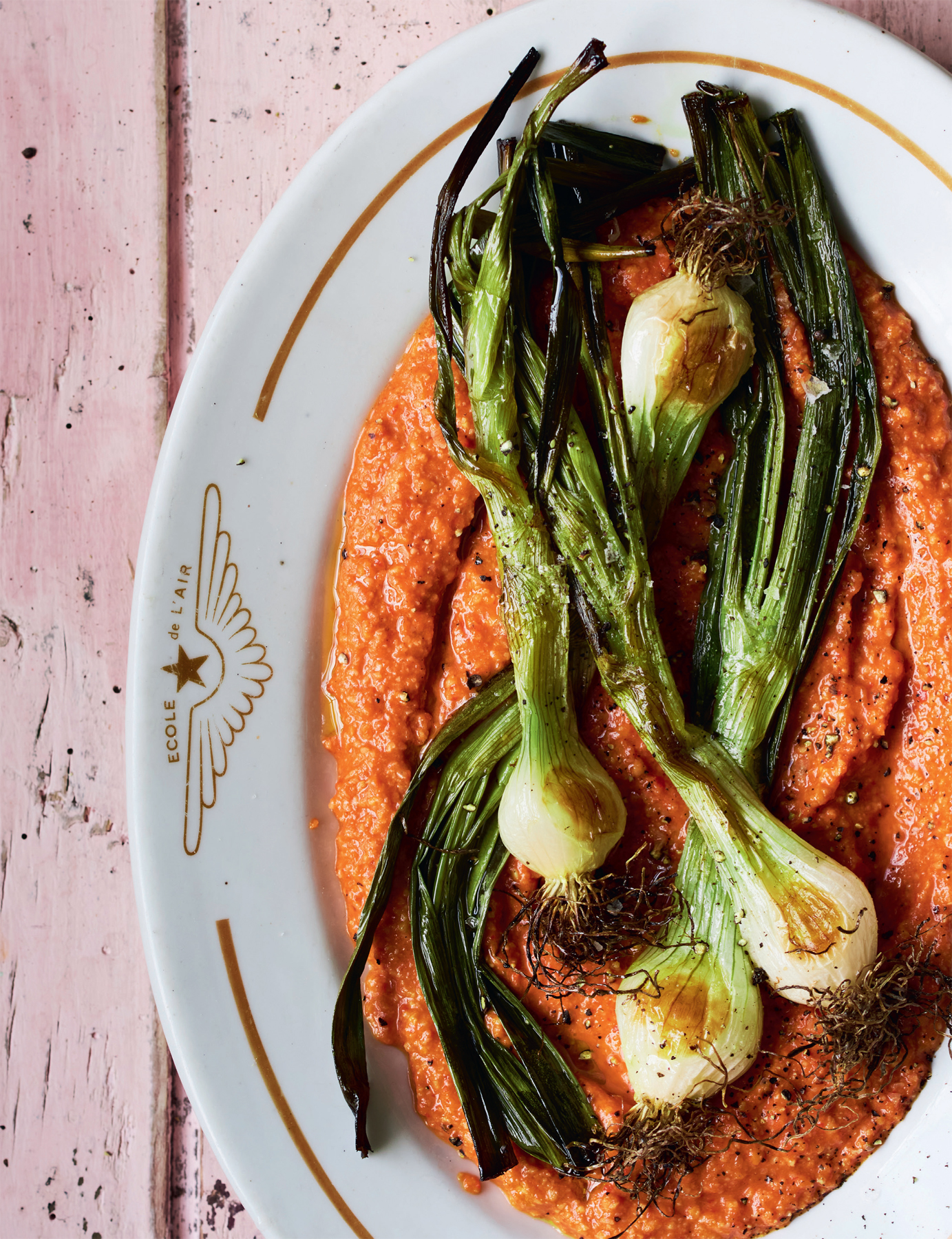
Peas, Broad Beans and Lettuce Gratin
Gratins tend to be carby and rich, but on seeing chef Anthony Demetre’s fricasée of English peas and broad beans, I was totally inspired to put my own spin on it. I started off by making a winey sauce, with a reduced chicken stock and lots of cream, and the flavours of tarragon and nutmeg running through it, before pouring it over peas and broad beans and baking. The result is an unusually fresh and light gratin that still has the richness of the cream, and works perfectly alongside roast chicken, or some sturdy collagen-rich fish such as hake or turbot.
I think freshly podded broad beans are the best, so do seek them out, especially when they are in season during summer. However, with peas, I have to admit to preferring frozen petits pois on the whole rather than fresh, as they are sweeter and less likely to be dry.
SERVES 4 as a side dish
Preparation time 15 minutes
Cooking time 15 minutes
200ml white wine
300g shelled fresh or frozen peas
300g podded broad beans
500ml fresh chicken stock
300ml double cream
juice of ½ lemon
1 little gem lettuce, roughly chopped
10 sprigs of tarragon, leaves removed and roughly chopped
¼ nutmeg, grated
20g Parmesan, grated
sea salt and freshly ground black pepper
Preheat the oven as hot as it can go (about 260°C/240°C fan/gas mark 10).
Pour the wine into a saucepan, place it over a high heat and reduce the volume by two thirds. While this is on the go, blanch the peas and broad beans in a pan of salted boiling water for about 2 minutes, then drain and refresh in ice-cold water to halt the cooking process.
Once the wine has reduced, add the stock and the cream and reduce again over a medium-high heat until the sauce has emulsified and thickened. Squeeze in the lemon juice, add the chopped lettuce to wilt it slightly, then add the tarragon leaves and season with the nutmeg and a healthy pinch of salt and pepper.
Drain the peas and beans and transfer them to an ovenproof gratin dish. Pour over the cream and lettuce sauce and top with the grated Parmesan. Place in the scorching-hot oven for 15 minutes, until the cheese is gratinated and golden. Remove from the oven and serve.
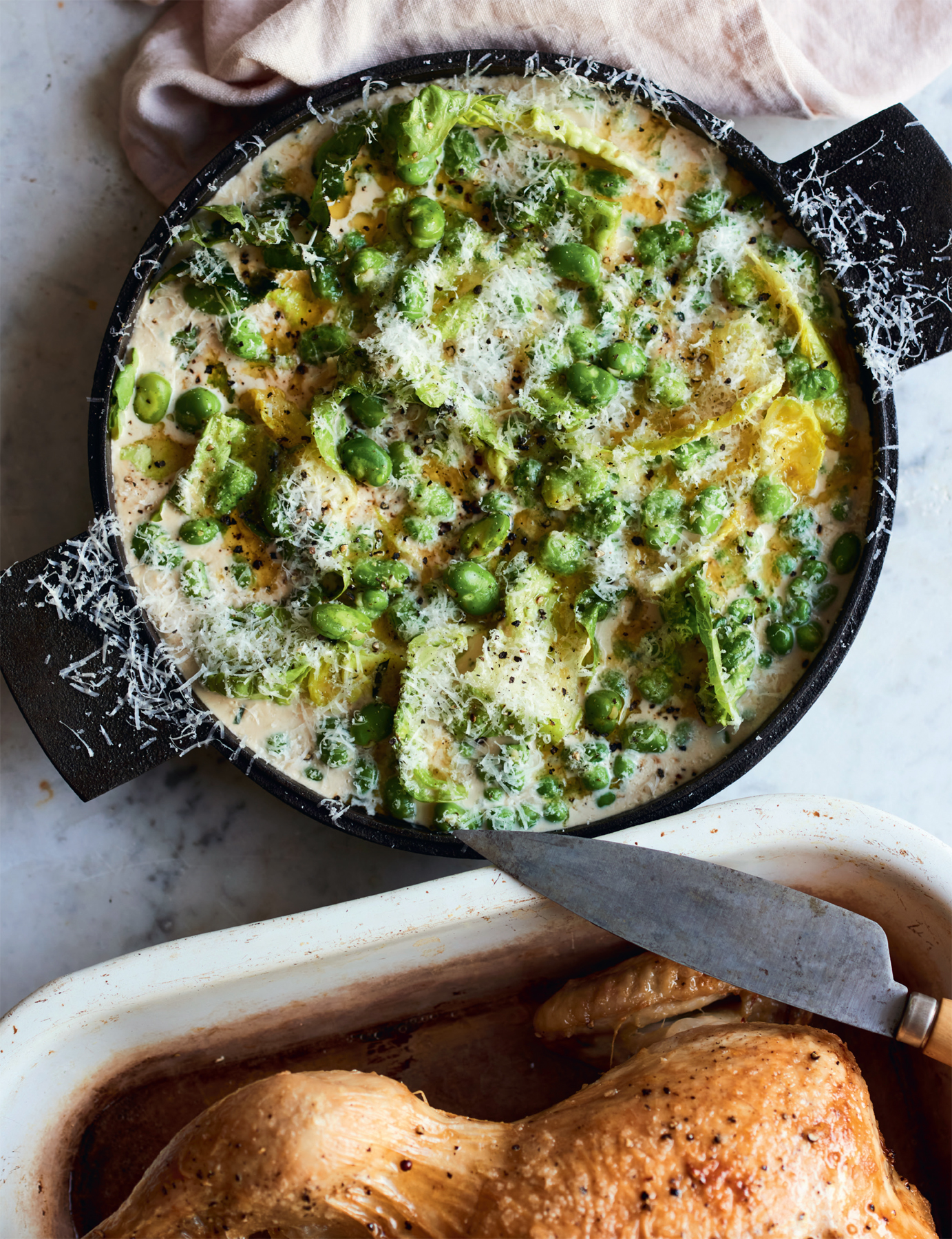
Patlican Salata
A number of the recipes in this book have come about as a direct result of living in Hackney and absorbing the influence of the large local Turkish communities. This was not my intention, but more of a subconscious osmosis. There are so many ocakbasi restaurants in my area (‘ocakbasi’ means ‘fireside’ or ‘stand by the grill’) with huge charcoal barbecue grills on which all kinds of meat and vegetables are cooked, and the side dishes and meze are just as big a part of their offering as the grilled meat. My assistant, Rose, alerted me to patlican salata, a buttery smoked aubergine, red pepper, garlic and yoghurt salad and perhaps one of the lesser known gems, and I can’t believe I’ve missed out on it all this time. Grill-roasted aubergines and peppers take on a delicious smokiness, and are then covered in a butter and yoghurt – it’s damn delicious in its simplicity. None of us have enormous grills but you can still achieve that smoky charred flavour through aggressive cooking on the hob. This is ideal served as part of a meze, alongside my Broad Bean, Mint and Feta Salad.
SERVES 4 as part of a meze
Preparation time 10 minutes
Cooking time 30 minutes
2 red peppers
6 tbsp oil
2 aubergines, cut into 2cm-thick rounds
1 head of Confit Garlic, cloves finely chopped, plus 2 tbsp of the oil
½ garlic clove, grated
large handful of flat-leaf parsley, leaves finely chopped
40g ghee
150g Greek yoghurt
sea salt flakes and freshly ground black pepper
pinch of pul biber, to serve
Preheat the oven as hot as it can go (about 260°C/240°C fan/gas mark 10).
Place the peppers on a baking tray and roast for 20 minutes until the skins are nice and charred. Remove from the oven, set aside and leave until cool enough to handle, then pull away the skins (they should come off pretty easily) and pull out the seeds.
Heat 2 tablespoons of the oil in a frying pan over a high heat, add a third of the aubergine rounds and cook for a few minutes on each side until well blackened. Don’t be scared: you need the aubergine to be a bit burnt to achieve a charred, smoky flavour. Lower the heat and fry for a further few minutes on each side until the aubergine is nice and soft. Do this in three batches, adding more oil to the pan as you go (the aubergines will soak it up like a sponge). Once all the aubergine is ready, chop it roughly as you want it to have a bit of texture. Do the same with the roasted red pepper and combine with the aubergine in a bowl. Mix in the confit garlic, fresh garlic and garlic oil, followed by the chopped parsley. Season generously.
If you work at the right pace this should all come together at the right time. Melt the ghee in a small saucepan over a low heat, being careful not to burn it. Spread the aubergine mixture on a plate, dollop the yoghurt in the centre and pour the ghee over the top. Finish with the pul biber. The salad doesn’t have to be hot, but it’s at its best when warm, so once the ghee hits the plate get it to the table pretty sharpish.
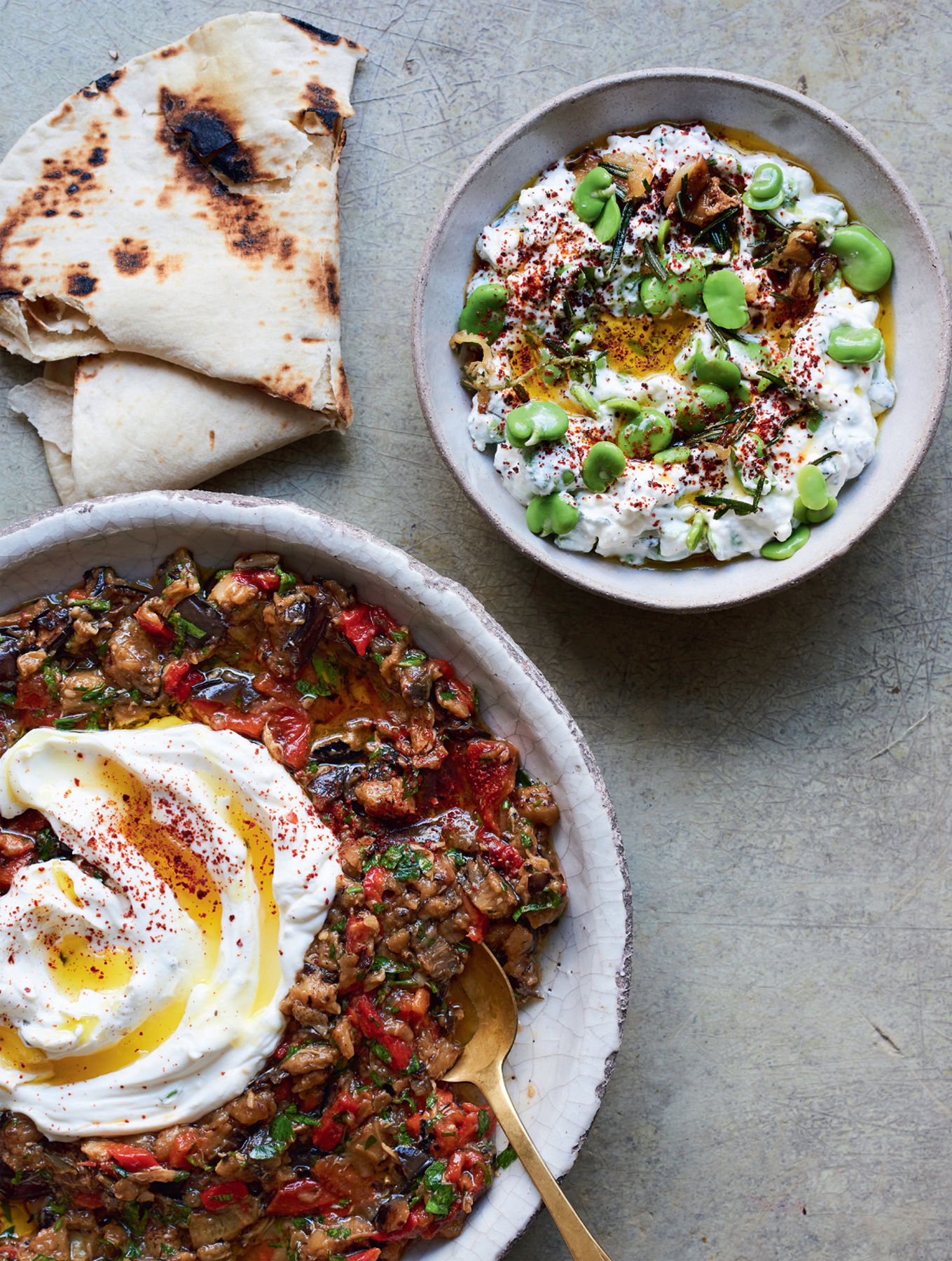
Egg and Bacon Potato Salad
Purple potatoes are a heritage potato variety from Peru, and Peruvians know how to cook them. Causa, their traditional cold potato salad, is made with lime juice and sour cream, and when I learnt about it I realised what a great addition the acidity of sour cream would be in a salad dressing. I created this potato salad recipe using classic American ingredients like bacon and jalapeños, but with causa in the back of my mind.
SERVES 4
Preparation time 10 minutes
Cooking time 20 minutes
1kg purple potatoes, scrubbed clean
2 litres cold water
2–3 tbsp salt
3 free-range eggs
110g smoked streaky bacon, cut into thin lardons
2 spring onions, thinly sliced
3 tbsp pickled jalapeño slices, finely chopped
smoked salt or celery salt, to serve (optional)
FOR THE DRESSING
150g sour cream
150g mayonnaise
2 tbsp lemon juice
good pinch of salt
good grind of black pepper
Put the potatoes in a large saucepan with the cold water and 2–3 tablespoons of salt. That might sound like lots of salt, but when cooking any potatoes it helps bring out their flavour. Bring to the boil and cook for 20 minutes, then drain and allow to steam dry.
Meanwhile, cook the eggs in a saucepan of boiling water for 8 minutes exactly, then place in a bowl of cold water to halt the cooking process. While the potatoes and eggs are cooking, fry the bacon in a frying pan until nice and crispy.


